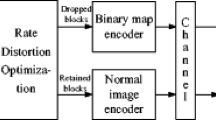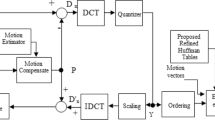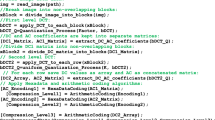Abstract
This paper proposes a compound image coding method named united coding (UC). In UC, several lossless coding tools such as dictionary-entropy coders, run-length encoding (RLE), Hextile, and a few filters used in portable network graphics (PNG) format are united into H.264 like intraframe hybrid video coding. The basic coding unit (BCU) has a size typically between 16 × 16 pixels to 64 × 64 pixels. All coders in UC are used to code each BCU. Then, the lossless coder that generates minimum bit-rate (R) is chosen as the optimal lossless coder. Finally, the final optimal coder is chosen from the lossy intraframe hybrid coder and the optimal lossless coder using R-D cost based optimization criterion. Moreover, the data coded by one lossless coder can be used as the dictionary of other lossless coders. Experimental results demonstrate that compared with H.264, UC achieves up to 20 dB PSNR improvement and better visual picture quality for compound images with mixed text, graphics and natural picture. Compared with lossless coders such as gzip and PNG, UC can achieve 2–5 times higher compression ratio with just a minor loss and keep partial-lossless picture quality. The partial-lossless nature of UC is indispensable for some typical applications, such as cloud computing and rendering, cloudlet-screen computing and remote desktop, where lossless coding of partial image regions is demanded. On the other hand, the implementation complexity and cost increment of UC is moderate, typically less than 25 % of a traditional hybrid coder such as H.264.
















Similar content being viewed by others
References
Advanced Video Coding for Generic Audiovisual Services (2010) ITU-T Rec. H.264
Alzina M, Szpankowski W, Grama A (2002) 2D-pattern matching image and video compression: theory, algorithms, and experiments. IEEE Trans Image Process 11(3):318–331
Armbrust M et al (2009) Above the clouds: A Berkeley view of cloud computing. Technical Report No. UCB/EECS-2009-28
Atallah M, Genin Y, Szpankowski W (1999) Pattern matching image compression: algorithmic and empirical results. IEEE Trans Pattern Anal Mach Intell 21(7):614–627
Bottou L, Haffner P, Howard PG, Simard P, Bengio Y, LeCun Y (1998) High quality document image compression with DjVu. J Electron Imag 7(3):410–425
Chen JM, Wei CH (1999) VLSI design for high-speed LZ-based data compression. IEE Proc Circ Dev Syst 146(5):268–278
Computer graphics and image processing-Portable Network Graphics (PNG): Functional specification (2004) ISO/IEC 15948
Ding W, Lu Y, Wu F (2007) Enable efficient compound image compression in H.264/AVC intra coding. In: Proc. IEEE Int. Conf. Image Processing, vol.2. San Antonio, pp 337–340
Francisco NC, Rodrigues NMM, da Silva EAB, de Carvalho MB, de Faria SMM, Silva VMM (2010) Scanned compound document encoding using multiscale recurrent patterns. IEEE Trans Image Process 19(10):2712–2724
Huttenlocher D, Felzenszwalb P, Rucklidge W (1999) Digipaper: a versatile color document image representation. In: Proc. IEEE Int. Conf. Image Processing, vol.1. Kobe, pp 219–223
JPEG 2000 image coding system (2002) ITU-T Rec. T.800
Konstantinides K, Tretter D (2000) A JPEG variable quantization method for compound documents. IEEE Trans Image Process 9(7):1282–1287
Kountchev R, Milanova M, Todorov V, Kountcheva R (2007) Adaptive compression of compound images. In: 14th International Workshop on systems, Signals and Image Processing and 6th Eurasip conference Focused on Speech and Image Processing, Multimedia Communications and Services. Maribor, pp 133–136
Lakhani G, Subedi R (2006) Optimal filling of FG/BG layers of compound document images. In: Proc. IEEE Int. Conf. Image Processing. Atlanta, pp 2273–2276
Lan C, Shi G, Wu F (2010) Compress compound images in H.264/MPGE-4 AVC by exploiting spatial correlation. IEEE Trans Image Process 19(4):946–957
Lan C, Peng X, Xu J, Wu F (2011) Intra and inter coding tools for screen contents. JCT-VC Doc JCTVC-E145
Lin T (2009) Achieving re-loss-free video coding. IEEE Signal Process Lett 16(4):323–326
Lin T, Hao P (2005) Compound image compression for real-time computer screen image transmission. IEEE Trans Image Process 14(8):993–1005
Lin T, Wang S (2009) Cloudlet-Screen Computing: A Multi-core-based, Cloud-computing-oriented, Traditional-computing-compatible Parallel Computing Paradigm for the Masses. In: IEEE Workshop on Multimedia Signal Processing and Novel Parallel Computing. New York, pp 1805–1808
Lin T, Hao P, Sang Uk Lee (2005) Efficient coding of computer generated compound images. In: Proc. IEEE Int. Conf. Image Processing, vol.1. Genoa, pp 561–564
Ma S, Kuo C-CJ (2007) High-definition video coding with supermacroblocks. SPIE Visual Communications and Image Processing Conference, vol. 6508. San Jose, pp 650816.828
Mixed Raster Content (MRC) ITU-T (1998) Recommendation T.44, Study Group-8 Contribution
Mogi T (1999) A hybrid compression method based on region separation for synthetic and natural compound images. In: Proc. IEEE Int. Conf. Image Processing, vol.3. Kobe, pp 777–781
Mukherjee D, Chrysafis C, Said A (2002) JPEG2000-matched MRC compression of compound documents. In: Proc. IEEE Int. Conf. Image Processing, vol.3. Vancouver, pp 73–76
Said A (2004) Compression of compound images and video for enabling rich media in embedded systems. SPIE Visual Communications and Image Processing Conference, Vol.5308. San Jose, pp 69–82
Said A, Drukarev A (1999) Simplified segmentation for compound image compression. In: Proc. IEEE Int. Conf. Image Processing, vol.1. Kobe, pp 229–233
Selvakumar RK, Nallaperumal K, Punithavathy A (2008) Compound video image compression for H.264/AVC-INTRA. In: Proceedings of IEEE International Conference on Computing, Communication and Networking. Karur, pp 1–7
Wang S, Lin T (2010) United coding for compound image compression. In: 3nd International Conference on Image and Signal Processing. Yantai, pp 566–570
Zaghetto A, de Queiroz RL (2007) Segmentation-driven compound document coding based on H.264/AVC-INTRA. IEEE Trans Image Process 16(7):1755–1760
Zaghetto A, de Queiroz RL, Mukherjee D (2008) MRC compression of compound documents using threshold segmentation, iterative data-filling and H.264/AVC-INTRA. In: Sixth Indian Conference on Computer Vision, Graphics & Image processing. Bhubaneswar, pp 679–686
Ziv J, Lempel A (1977) A universal algorithm for sequential data compression. IEEE Trans Inf Theory 23(3):337–343
Acknowledgments
This work was supported in part by NSFC under Grant No. 61201226 and Grant No. 61271096, the Natural Science Foundation of Shanghai under Grant No. 12ZR1433800 and the Fundamental Research Funds for the Central Universities of China under Grant No. 2810219002 and Grant No. 2810219003.
Author information
Authors and Affiliations
Corresponding author
Rights and permissions
About this article
Cite this article
Wang, S., Lin, T. United coding method for compound image compression. Multimed Tools Appl 71, 1263–1282 (2014). https://doi.org/10.1007/s11042-012-1274-y
Published:
Issue Date:
DOI: https://doi.org/10.1007/s11042-012-1274-y




